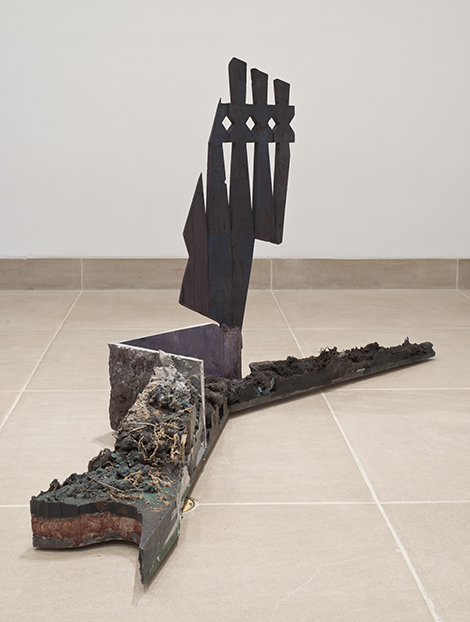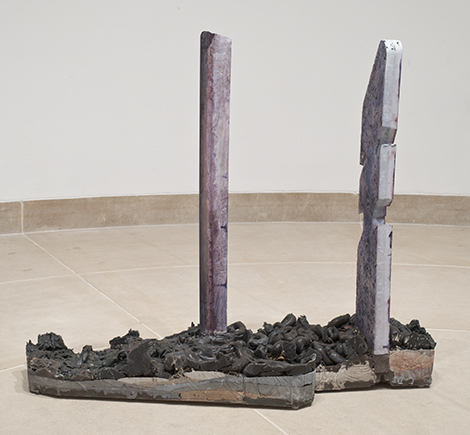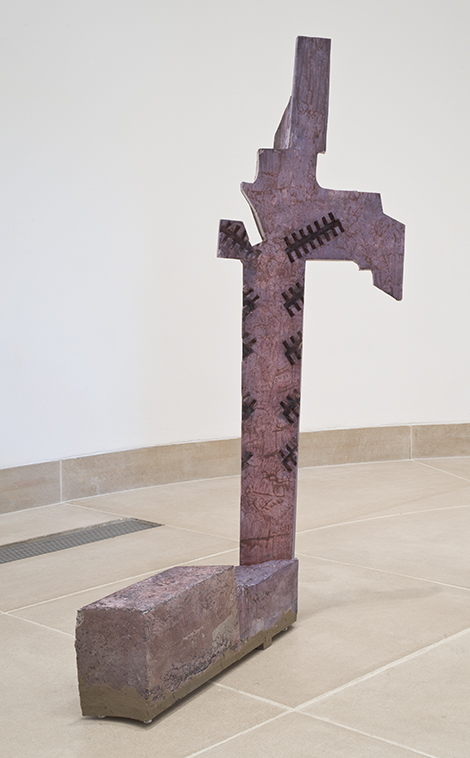Death becomes her, there really is no better way to describe Andra Ursuta’s first solo show in the US.
Ursuta’s work has been dark, conceptual, sexually-charged and fueled by a death obsession; now fear is the impetus for creating a fictional graveyard in the Hammer Museum’s project space. Terrified to enter an actual cemetery, this is the second imagined version Ursuta has manifested. The first, a commissioned work for Frieze NYC 2013, depicted geometric grave markers installed on the lawn outside the art fair village, an abstracted location where forgotten art goes to die.
While the Hammer Projects exhibition initially feels like a misuse of space to the point of being uncomfortable, this component ultimately makes Ursuta’s exhibition conceptually successful. Eleven precarious floor works, each a mock tombstone with a sculptural representation of its shadow, renders it nearly impossible to navigate one’s way through the works without feeling on the verge of an anxiety episode. A singular object without a shadow is a tall white obelisk, a monochromatic monument rising above the chaos. Ursuta’s perverse sense of humor cuts through the noticeable tension with titles such as Future Husbands, In Some War and 1957-Cancer (all works 2014).
The sculptures are dichotomies of painstakingly finished headstones styled like striking minimalist sculptures, paired with loose and fast shadow sections—many with the feeling of a violent AbEx painting. If painting were truly dead, this alludes to a sculptural resurrection. They are two-tiered psychological objects, the vertical representing a form made with careful planning, calculated mold-making, and utter control in execution; the horizontal embraces the loss of that control. It is an emotional style of creation, which seizes the moment, the trauma, the unspeakable feelings. Jesting with traditional sculptural aesthetics, the base becomes integral to the emotional content and structural integrity of the work.
The physicality of materials is evident in subsequent layers cast to build this mass of shadows. The objects take on the feel of excavated terra firma, in a painterly and metaphorical way echoing Nobuo Sekine’s Phase-Mother Earth (1968), where stratums of earth were transposed from the ground. Several shadows in Ursuta’s work include buried consumer elements such as fluorescently-colored Nike’s. These found objects are obscured beneath layers of fecal-colored material, visible as negative space or implied caverns that can be seen in the cross section of the shadow’s edge. While evoking historic John Miller brown paintings, the shadow allows the viewer a glimpse behind the curtain. John Miller’s Untitled (1990) even exists within proximity, a part of the Hammer’s simultaneous “Take It or Leave It” exhibit. Could this be a subtle comment on her predecessors’ institutional critique?
In the end, simple aesthetic beauty does not define an artwork as good or bad. Andra Ursuta’s exhibition, while successful, walks a fine line between simple minimalist forms, repulsive references, and the creation of a general sense of unease. Ursuta effectively takes us to the dark reaches of her mind; luckily, we don’t have to stay too long.






















0 Comments